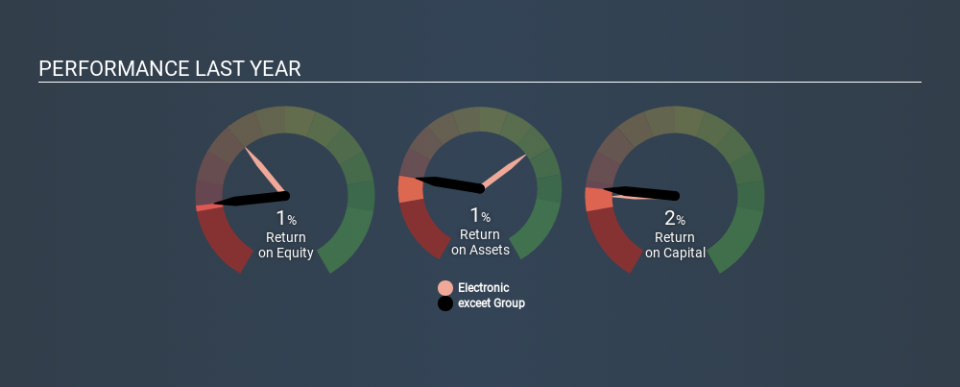How Do exceet Group SA’s (ETR:EXC) Returns Compare To Its Industry?

Today we'll evaluate exceet Group SA (ETR:EXC) to determine whether it could have potential as an investment idea. In particular, we'll consider its Return On Capital Employed (ROCE), as that can give us insight into how profitably the company is able to employ capital in its business.
First, we'll go over how we calculate ROCE. Then we'll compare its ROCE to similar companies. Finally, we'll look at how its current liabilities affect its ROCE.
What is Return On Capital Employed (ROCE)?
ROCE measures the 'return' (pre-tax profit) a company generates from capital employed in its business. All else being equal, a better business will have a higher ROCE. In brief, it is a useful tool, but it is not without drawbacks. Renowned investment researcher Michael Mauboussin has suggested that a high ROCE can indicate that 'one dollar invested in the company generates value of more than one dollar'.
So, How Do We Calculate ROCE?
Analysts use this formula to calculate return on capital employed:
Return on Capital Employed = Earnings Before Interest and Tax (EBIT) ÷ (Total Assets - Current Liabilities)
Or for exceet Group:
0.019 = €2.6m ÷ (€150m - €8.7m) (Based on the trailing twelve months to September 2019.)
So, exceet Group has an ROCE of 1.9%.
See our latest analysis for exceet Group
Is exceet Group's ROCE Good?
One way to assess ROCE is to compare similar companies. We can see exceet Group's ROCE is meaningfully below the Electronic industry average of 11%. This performance is not ideal, as it suggests the company may not be deploying its capital as effectively as some competitors. Independently of how exceet Group compares to its industry, its ROCE in absolute terms is low; especially compared to the ~-0.4% available in government bonds. Readers may wish to look for more rewarding investments.
Our data shows that exceet Group currently has an ROCE of 1.9%, compared to its ROCE of 1.1% 3 years ago. This makes us think the business might be improving. You can click on the image below to see (in greater detail) how exceet Group's past growth compares to other companies.
When considering this metric, keep in mind that it is backwards looking, and not necessarily predictive. Companies in cyclical industries can be difficult to understand using ROCE, as returns typically look high during boom times, and low during busts. This is because ROCE only looks at one year, instead of considering returns across a whole cycle. Future performance is what matters, and you can see analyst predictions in our free report on analyst forecasts for the company.
Do exceet Group's Current Liabilities Skew Its ROCE?
Liabilities, such as supplier bills and bank overdrafts, are referred to as current liabilities if they need to be paid within 12 months. Due to the way the ROCE equation works, having large bills due in the near term can make it look as though a company has less capital employed, and thus a higher ROCE than usual. To check the impact of this, we calculate if a company has high current liabilities relative to its total assets.
exceet Group has total assets of €150m and current liabilities of €8.7m. As a result, its current liabilities are equal to approximately 5.8% of its total assets. exceet Group has very few current liabilities, which have a minimal effect on its already low ROCE.
The Bottom Line On exceet Group's ROCE
Nevertheless, there are potentially more attractive companies to invest in. But note: make sure you look for a great company, not just the first idea you come across. So take a peek at this free list of interesting companies with strong recent earnings growth (and a P/E ratio below 20).
I will like exceet Group better if I see some big insider buys. While we wait, check out this free list of growing companies with considerable, recent, insider buying.
If you spot an error that warrants correction, please contact the editor at editorial-team@simplywallst.com. This article by Simply Wall St is general in nature. It does not constitute a recommendation to buy or sell any stock, and does not take account of your objectives, or your financial situation. Simply Wall St has no position in the stocks mentioned.
We aim to bring you long-term focused research analysis driven by fundamental data. Note that our analysis may not factor in the latest price-sensitive company announcements or qualitative material. Thank you for reading.

 Yahoo Finance
Yahoo Finance 
